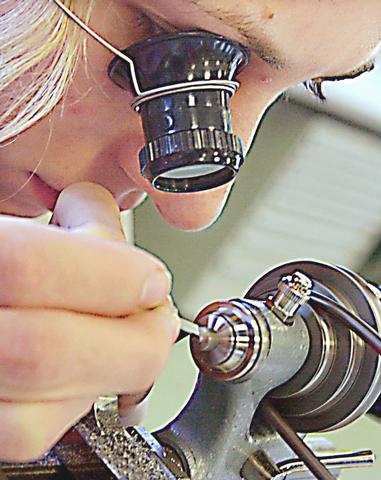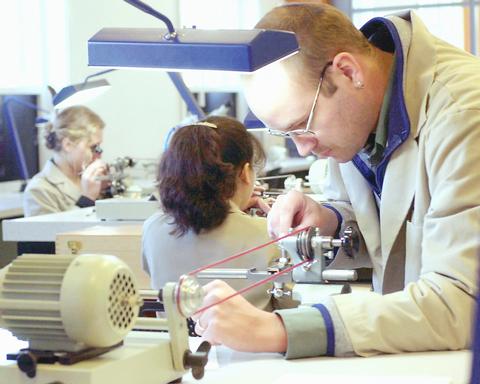The daughter of an auto mechanic, Brigitte Keesey has a combination of interests that make her a good candidate for working with intricate and beautiful timepieces.
"I used to work in a wood shop, and I was in school for art," Keesey said. "If you combine the two of them, somewhere you find watch repair."

PHOTO: AP
Dearth of expertise

PHOTO: AP
Keesey, 23, is in the first class of students at the Lititz Watch Techni-cum -- Swiss manufacturer Rolex's answer to the dearth of skilled watchmakers that has occurred amid the popularity of electronic quartz timepieces.
The school is managed by a foundation created by Rolex and is operated under the guidance of a Swiss institution. It opened in September in this Pennsylvania Dutch region that has long ties to clock and watch craftsmanship.
The tuition-free school, which plans to take in 12 artisans a year, is a step toward filling a growing void -- only 10 watchmaking schools remain in the US, compared with 44 in the mid-1970s, according to the American Watchmakers-Clockmakers Institute.
An overabundance of watchmakers and the growing popularity of cheaper quartz watches in the 1970s led to tough times in the business as well as a widespread belief that mechanical timepieces were on their way out. Many watchmakers left the industry and pursued work with defense contractors, where their ability to work with intricate mechanics was in demand.
But sales of mechanical timepieces, especially high-grade ones, have made a comeback, said Charles Berthiaume, director of the school. The improvement in business created a demand for people who know how to fix the timepieces, which tend to be more expensive and more likely to need regular servicing than their electronic counterparts.
"With the shortage of watchmakers, we're literally missing a generation," Berthiaume explained. "The average age of a watchmaker in this country is in the mid-50s."
Micromechanics
Inside one of the classrooms, students sit quietly at workbenches fashioning pieces of machinery less than 2.5cm in length. The school starts its students with a course in micromechanics, which involves the making of tiny parts.
The learning process can be long and laborious.
Ron Landberg spent a day making a small, pin-like part only to discover that he had erred by thousandths of a centimeter and had to start all over again. A hobbyist who decided to turn his avocation into a full-time craft, Landberg wrote off the experience as an exercise in patience.
The same patience is needed when a spinning lathe sends a part shooting from the grasp of tweezers and across the room, with only a tiny ping disclosing where it landed.
"Right now, everything we're doing is setting the foundation for being able to do things that people can't do anymore," said Landberg, 37, noting that most modern watch repairs involve simply replacing broken parts with pre-made components.
"We're learning how to make those parts," he said.
By the end of the second year, students at the Lititz school will have learned skills allowing them to fix most brands of watches, both mechanical and electronic, Berthiaume said. Ideally, students will find work alongside a more experienced watchmaker, where they can continue their education, he said.
When they graduate, all indications are that they will be in demand in an industry hungry for young talent.
"We have 100 percent placement," said Daniel Nied, director of the school of horology operated by the National Association of Watch and Clock Collectors in nearby Columbia. Horology is the study of measuring time or making timepieces.
Many graduates earn between US$35,000 and US$40,000 a year when they start out, but salaries of US$60,000 or more after several years are possible, said James Lubic, executive director of the American Watchmakers-Clockmakers Institute.
Manufacturers' support
Other manufacturers, too, are looking at providing support for schools, although none so far have taken the step that Rolex has, said Lubic, who is seeking industry support for another new school.
Although mechanical watches account for only about 10 percent of production in the watch industry, they make up more than 50 percent of revenue, Lubic said. The average price of a mechanical watch is nearly US$1,000, making them items that are not merely thrown away when in disrepair.
"There's so much opportunity out there," Lubic said. "There are jobs working with industry. There are retailers all over the country, all over the world, that are begging for watchmakers to come in and service what they sell."

SECURITY: As China is ‘reshaping’ Hong Kong’s population, Taiwan must raise the eligibility threshold for applications from Hong Kongers, Chiu Chui-cheng said When Hong Kong and Macau citizens apply for residency in Taiwan, it would be under a new category that includes a “national security observation period,” Mainland Affairs Council (MAC) Minister Chiu Chui-cheng (邱垂正) said yesterday. President William Lai (賴清德) on March 13 announced 17 strategies to counter China’s aggression toward Taiwan, including incorporating national security considerations into the review process for residency applications from Hong Kong and Macau citizens. The situation in Hong Kong is constantly changing, Chiu said to media yesterday on the sidelines of the Taipei Technology Run hosted by the Taipei Neihu Technology Park Development Association. With

CARROT AND STICK: While unrelenting in its military threats, China attracted nearly 40,000 Taiwanese to over 400 business events last year Nearly 40,000 Taiwanese last year joined industry events in China, such as conferences and trade fairs, supported by the Chinese government, a study showed yesterday, as Beijing ramps up a charm offensive toward Taipei alongside military pressure. China has long taken a carrot-and-stick approach to Taiwan, threatening it with the prospect of military action while reaching out to those it believes are amenable to Beijing’s point of view. Taiwanese security officials are wary of what they see as Beijing’s influence campaigns to sway public opinion after Taipei and Beijing gradually resumed travel links halted by the COVID-19 pandemic, but the scale of

A US Marine Corps regiment equipped with Naval Strike Missiles (NSM) is set to participate in the upcoming Balikatan 25 exercise in the Luzon Strait, marking the system’s first-ever deployment in the Philippines. US and Philippine officials have separately confirmed that the Navy Marine Expeditionary Ship Interdiction System (NMESIS) — the mobile launch platform for the Naval Strike Missile — would take part in the joint exercise. The missiles are being deployed to “a strategic first island chain chokepoint” in the waters between Taiwan proper and the Philippines, US-based Naval News reported. “The Luzon Strait and Bashi Channel represent a critical access

Pope Francis is be laid to rest on Saturday after lying in state for three days in St Peter’s Basilica, where the faithful are expected to flock to pay their respects to history’s first Latin American pontiff. The cardinals met yesterday in the Vatican’s synod hall to chart the next steps before a conclave begins to choose Francis’ successor, as condolences poured in from around the world. According to current norms, the conclave must begin between May 5 and 10. The cardinals set the funeral for Saturday at 10am in St Peter’s Square, to be celebrated by the dean of the College